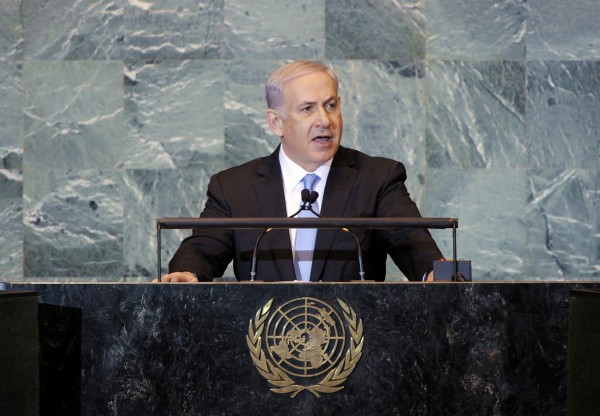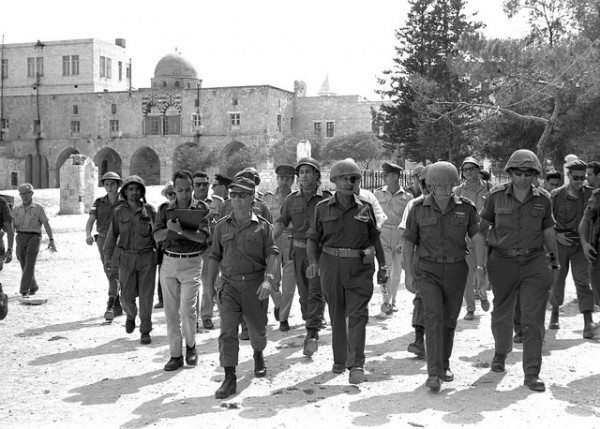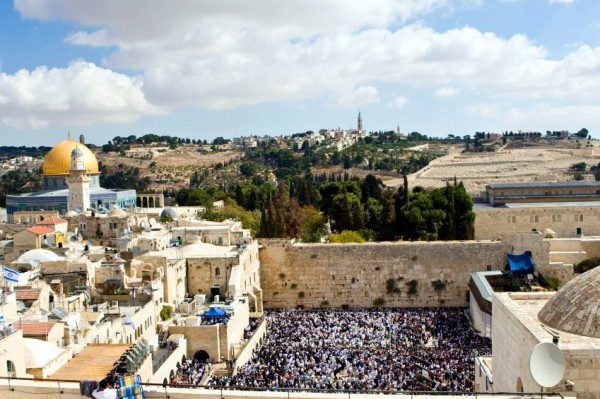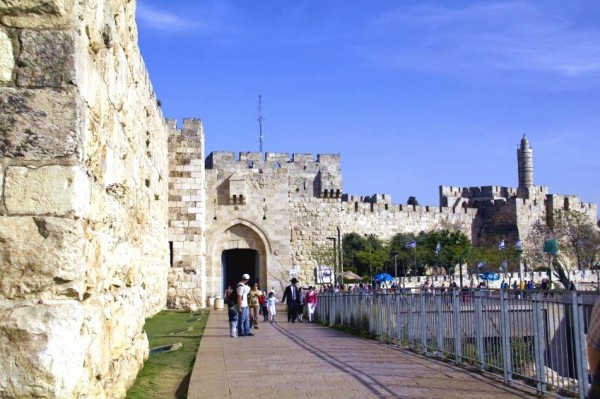“I rejoiced with those who said to me, ‘Let us go to the house of the Lord.’ Our feet are standing in your gates, O Jerusalem.” (Psalm 122:1–2)
Today is Yom Yerushalayim (Jerusalem day), a day to celebrate the 46th anniversary of the historic liberation and reunification of Jerusalem in 1967’s Six Day War!
On this day, the whole of Jerusalem once again came under Jewish sovereignty for the first time in 2000 years!
It was the fulfillment of promise, longing and hope.
Israeli Prime Minister Benjamin Netanyahu conveyed that hope in a speech he delivered at the United Nations General Assembly in 2011:
“For those Jews who were exiled from our land, they never stopped dreaming of coming back: Jews in Spain, on the eve of their expulsion; Jews in the Ukraine, fleeing the pogroms; Jews fighting the Warsaw Ghetto, as the Nazis were circling around it. They never stopped praying, they never stopped yearning. They whispered: Next year in Jerusalem. Next year in the Promised Land.”
“When the LORD restored the fortunes of Zion, we were like those who dreamed. Our mouths were filled with laughter, our tongues with songs of joy. Then it was said among the nations, ‘The LORD has done great things for them.'” (Psalm 126:1–2)

Israeli Prime Minister Benjamin Netanyahu conveys to the UN General Assembly the longstanding importance of Jerusalem to the Jewish People.
Jerusalem Day: Connection to the Bible
“Jerusalem … That is where the tribes go up, the tribes of the Lord, to praise the name of the Lord according to the statute given to Israel.” (Psalm 122:3–4)
This public holiday in Israel, which is marked on the 28th day of Iyar, is the most recent addition to the Hebrew calendar.
Although Jerusalem was reunified on June 7, 1967, because of differences between the Gregorian and Hebrew calendars, Jerusalem Day falls on May 8th in 2013.
It is a day of public celebration that is characterized by a general outpouring of joy.
Thousands of Israelis have traveled to Jerusalem today to show solidarity with the city and visit the Old City and the Western (Wailing) Wall.
Celebrations include state ceremonies and memorial services for soldiers who were killed in the fight for Jerusalem in 1967.
There are also parades through Jerusalem, dancing, singing, and special television programs.
The Hallel, a special holiday prayer of praise and thanksgiving that recites Psalms 113–118, will be offered in synagogues.
Though it is most deeply celebrated in Jerusalem itself, Jerusalem Day engages the national sentiment of schoolchildren and college students throughout Israel, as well as that of Christian and Jewish Zionists around the world.
“It’s an event that’s integrated into the identity of Jewish Israelis,” said Ma’ayan Nissim, an Israeli student at The Jerusalem Academy of Music and Dance.
“It’s sort of a holiday that connects everyone, because it connects you back to the Bible and it connects you to your relatives that were in the war and the friends that you knew were there—it connects to our days and back to our history as a nation,” she said.
Yom Yerushalayim (Jerusalem Day) is a wonderful opportunity to reflect on the prophetic end-time return of the Jewish People to the Holy Land, and the faithfulness of God.
“I myself will gather the remnant of my flock out of all the countries where I have driven them and will bring them back to their pasture, where they will be fruitful and increase in number.” (Jeremiah 23:3)
Furthermore, God chose Jerusalem and guaranteed its eternal status:
“Jerusalem will remain intact in her place.” (Zechariah 12:6)
Why? Because it is God’s dwelling place.
“For the Lord has chosen Zion, He has desired it for His dwelling, saying, ‘This is My resting place for ever and ever.’” (Psalm 132:13–14)
1949: Jerusalem Divided
After Israel miraculously became an independent nation in 1948, the armies of Egypt, Iraq and Jordan, as well as troops from Syria, forced the newborn state into a brutal, disproportionate war.
Jerusalem was divided for the first time in the city’s history with the April 1949 Jordanian-Israeli ceasefire.
During the bully-style war against the newborn Israeli state, Jordan had taken control of the surrounding areas of East Jerusalem, including the Old City of Jerusalem, the Western (Wailing) Wall and the Temple Mount.
Once in power, they attempted to erase the Jewishness of Jerusalem.
By the end of the Arab-Israeli War, the Jordanian army had forced all the Jewish residents of the Old City of Jerusalem from their homes, and many Jews and Arabs fled Jerusalem.
Though neither Israel nor Jordan considered the 1949 armistice lines to be permanent borders, the Kingdom of Jordan flexed its muscles over now Jordanian-occupied East Jerusalem and violated the ceasefire by refusing Jewish access to Jordanian-held areas.
As a result, Jews were unable to reach the Hebrew University and Hadassah Hospital and were forbidden from praying at the Western Wall, a Jewish tradition older than Islam itself.
Jordan also destroyed the synagogues of the Old City, desecrated the Jewish cemetery on the Mount of Olives, and kept Israeli Christians, Muslims and all Jews from the holy sites in East Jerusalem.
Between Jordanian-held eastern Jerusalem and Israeli-held western Jerusalem lay a border of minefields and barbed wire.
While the Jordanian policies continued to keep its occupied portion of Jerusalem in disrepair and disunity, the Israeli-held zones in the west of the city thrived.

Israeli policemen meet a Jordanian legionnaire near the Mandelbaum Gate on the ceasefire line that went through Jerusalem between 1949 and June 1967.
1967: The Six Day War
“When I bring them back from captivity, the people in the land of Judah and in its towns will once again use these words: ‘The LORD bless you, you prosperous city, you sacred mountain.’” (Jeremiah 31:23)
It took 19 years before another war between Jordan and Israel reunified the capital city under the Israeli flag.
While the Arab nations were once again working themselves up to attack Israel, Israel asked Jordan to maintain the ceasefire which they had kept until then.
Despite this, by the end of May 1967, Jordan had signed a military agreement with Egypt and Syria, promising artillery to help split the Israeli nation in two at the town of Qalqilya, where only 12 kilometers (about eight miles) separated the Jordanian ceasefire line and the Mediterranean Sea. (Al Akhbar)
“Those who survive will remain in Palestine. I estimate that none of them will survive,” said Ahmed Shukairy, chairman of the PLO in Jordanian-occupied Jerusalem, on June 1, 1967.
In June 1967, Israeli Foreign Minister Abba Eban described the formidable Arab militia on Israel’s southern border as “an army, greater than any force ever assembled in history in Sinai,” with 80,000 men and 900 tanks ready to attack.

Six Day War: (left to right) Jerusalem Commander Uzi Narkis, Defense Minister Moshe Dayan, IDF Chief of Staff Yitzhak Rabin, and General Rehavam Ze’evi walk through the Old City of Jerusalem.
“It was the surprise attack of the IAF [Israel Air Force] on Egypt and Syria, the pre-emptive factor, the audacity of the Israelis and their highly trained and motivated military that secured Israel its lightning fast, comprehensive victory,” said Stan Goodenough, a 25-year resident of Jerusalem and South African citizen, who is a journalist, writer and Israel-licensed tour guide.
Jordan’s part in assaulting Israel was a final, barefaced violation of the ceasefire, and it permitted Israel to consider the agreement no longer valid.
On Iyar 28 (June 7) in 1967, Israel regained control of Jerusalem in one day, after Jordan began shooting at Israeli citizens.
The victory allowed Israel to extract the eastern part of its capital from Jordanian hands, sealing Israel’s national rebirth with an even deeper cause for celebration—the restoration of Jerusalem.
“The Lord builds up Jerusalem; He gathers the exiles of Israel. He heals the brokenhearted and binds up their wounds.… Extol the Lord, Jerusalem; praise your God, Zion. He strengthens the bars of your gates and blesses your people within you. He grants peace to your borders and satisfies you with the finest of wheat.” (Psalm 147:2–3, 12–14)
Today: Jerusalem Day
“They will rebuild the ancient ruins and restore the places long devastated; they will renew the ruined cities that have been devastated for generations.” (Isaiah 61:4)
Once the eastern portion of Jerusalem was taken back from Jordan, Israel began renovating the city as a whole and enabling worshipers of all faiths to once again access the holy places of Jerusalem.
“The fact that Israel is the authority allows the city to be open to the whole world,” Ma’ayan Nissim said. “It’s refreshing to be there. It’s exciting because you realize that it’s thick with history, and … all the celebrations of cultures in one place is really unforgettable.”
While people still distinguish between “east” and “west” Jerusalem when discussing the rights of Jewish or Palestinian residents, good enough explains the error in enforcing that division:
“Jewish neighborhoods dominate ‘East J,'” he said. “‘East Jerusalem’ is a political concept only—and only one used by Israel’s foes. The city is twice the size it was in 1967 and growing in leaps and bounds.”

East Jerusalem refers to the area captured and annexed by Jordan in 1949. Although Ramallah is the Palestinian’s administrative capital, the Palestinians seek to re-divide Jerusalem and have East Jerusalem as the capital of a Palestinian state.
Nissim, who is in her early 20s, said her generation is beginning to forget the cost its parents and grandparents paid to lay the groundwork for the State.
Though Israel isn’t perfect and there are things that need to be fixed here, she said, the modern-day state of Israel is still young, and coming to Israel was and is still the fulfillment of a dream.
“It’s a wish of two thousand years come true … the re-collection of the people to Israel—like in the end of days—that’s the picture people had in mind, that they were coming back fulfilling the prophets’ words.”
“This is what the LORD says—your Redeemer, who formed you in the womb: I am the LORD, the Maker of all things, who stretches out the heavens, who spreads out the earth by myself, … who says of Jerusalem, ‘It shall be inhabited,’ of the towns of Judah, ‘They shall be rebuilt,’ and of their ruins, ‘I will restore them.'” (Isaiah 44:24–26)

All over Israel today, the Israeli flag is flying—a testimony of the faithfulness of God and the integrity of His Word.
Today, over six million Jewish People call Israel home, and according to the data released Monday by Israel’s Central Bureau of Statistic (CBS), Jerusalem is Israel’s most populated city.
Of the 804,000 people living in Jerusalem as of 2011, 62 percent are Jewish, 35 percent are Muslim, two percent are Christian, and one percent did not declare religion. (CBS)
Despite the large percentage of Jews living in Israel’s ancient capital, many around the globe have joined the chorus of Palestinians demanding that Jerusalem be re-divided along the 1967 lines, and Judea and Samaria (West Bank) be handed over to the Palestinians.

The Jewish Quarter in Jerusalem: The Jewish People have maintained a continuous presence in the Holy Land for over 3,000 years.
Many of those demanding this deny the Jewish People’s historical connection to their ancient homeland and accuse Israel of deliberately Judaizing Jerusalem.
At the United Nations General Assembly in 2011, Prime Minister Netanyahu challenged this belief saying:
“I often hear them accuse Israel of Judaizing Jerusalem. That’s like accusing America of Americanizing Washington, or the British of Anglicizing London. You know why we’re called ‘Jews’? Because we come from Judea.” (Jewish Virtual Library)
The fact that Israel has once again become a nation and the Jewish People now live again in their ancient capital defies all natural odds. It is evidence that God’s Spirit is moving in the midst of His Chosen People and that God’s Word is true.
















